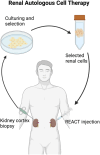Cell therapy in kidney diseases: advancing treatments for renal regeneration
- PMID: 39723242
- PMCID: PMC11669058
- DOI: 10.3389/fcell.2024.1505601
Cell therapy in kidney diseases: advancing treatments for renal regeneration
Abstract
Kidney diseases, including acute kidney injury (AKI) and chronic kidney disease (CKD), pose a significant global health challenge, with high morbidity and mortality rates driven by rising prevalence of risk factors such as diabetes and hypertension. Current therapeutic strategies are often limited, prompting the exploration of advanced cell therapies as potential solutions. This review provides a comprehensive overview of the state of cell therapies in kidney disease, tracing the progression from preclinical studies to clinical applications. Recent studies highlited that cell-based interventions offer kidney-protective properties through mechanisms such as paracrine signaling, immune modulation, and direct tissue integration, demonstrating potential in both AKI and CKD settings. Despite promising results, challenges remain in optimizing cell therapy protocols, including cell sourcing, delivery methods, and long-term outcomes. Finally, the review addresses on efforts to enhance cell function, optimize dosing, and refine delivery techniques to improve clinical outcomes in kidney disease management.
Keywords: CD34 cells; acute kidney injury; cell therapy; chronic kidney diseases; kidney diseases; mesenchimal stem cells.
Copyright © 2024 Salybekov, Kinzhebay and Kobayashi.
Conflict of interest statement
The authors declare that the research was conducted in the absence of any commercial or financial relationships that could be construed as a potential conflict of interest.
Figures
Similar articles
-
Mesenchymal Stem Cell-Derived Extracellular Vesicles to the Rescue of Renal Injury.Int J Mol Sci. 2021 Jun 20;22(12):6596. doi: 10.3390/ijms22126596. Int J Mol Sci. 2021. PMID: 34202940 Free PMC article. Review.
-
Lymphocytes: Versatile Participants in Acute Kidney Injury and Progression to Chronic Kidney Disease.Front Physiol. 2021 Sep 20;12:729084. doi: 10.3389/fphys.2021.729084. eCollection 2021. Front Physiol. 2021. PMID: 34616308 Free PMC article. Review.
-
Regenerative pharmacology for the treatment of acute kidney injury: Skeletal muscle stem/progenitor cells for renal regeneration?Pharmacol Res. 2016 Nov;113(Pt B):802-807. doi: 10.1016/j.phrs.2016.03.014. Epub 2016 Mar 18. Pharmacol Res. 2016. PMID: 27001227 Review.
-
The Role of Mitochondria in Acute Kidney Injury and Chronic Kidney Disease and Its Therapeutic Potential.Int J Mol Sci. 2021 Oct 19;22(20):11253. doi: 10.3390/ijms222011253. Int J Mol Sci. 2021. PMID: 34681922 Free PMC article. Review.
-
Potential targeted therapy and diagnosis based on novel insight into growth factors, receptors, and downstream effectors in acute kidney injury and acute kidney injury-chronic kidney disease progression.Signal Transduct Target Ther. 2020 Feb 14;5(1):9. doi: 10.1038/s41392-020-0106-1. Signal Transduct Target Ther. 2020. PMID: 32296020 Free PMC article. Review.
Cited by
-
Worldwide hotspots and trends in stem cell therapy for kidney disease in the last decade: a bibliometric and visualization analysis from 2015 to 2024.Front Immunol. 2025 Jul 21;16:1619291. doi: 10.3389/fimmu.2025.1619291. eCollection 2025. Front Immunol. 2025. PMID: 40761782 Free PMC article.
-
3D Bioprinted Renal Constructs Using Kidney-Specific ECM Bioink System on Kidney Regeneration.Adv Healthc Mater. 2025 Jun 26:e2502576. doi: 10.1002/adhm.202502576. Online ahead of print. Adv Healthc Mater. 2025. PMID: 40574386
References
-
- Brosnahan G., et al. (2021). Cell therapy for kidney diseases: advances and future directions. Front. Cell Biol. Dev. 10.3389/fcell.2021.685428 - DOI
Publication types
LinkOut - more resources
Full Text Sources



